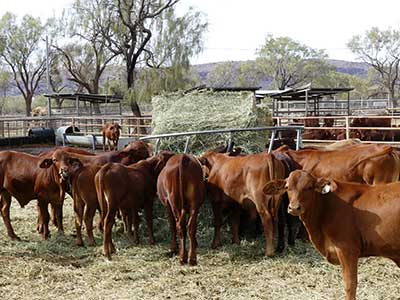Adding the SURF to the TURF to reduce greenhouse gas emissions of cattle
There is growing concern about the increasing levels of greenhouse gases in the atmosphere and the effect these are having on global climate. The subsequent spotlight on the cattle industry is driving a lot of research into reducing methane emissions in livestock production systems. In an effort to further reduce emissions, Meat and Livestock Australia (MLA) have set a target for Australia’s red meat and livestock industry to be carbon neutral by 2030.
Various researchers around the world have investigated the concept of feeding anti-methanogenic compounds to cattle as these compounds suppress methane production. One that is attracting a lot of attention in Australia is Asparagopsis seaweed, which contains an active ingredient called bromoform. Scientists from CSIRO and James Cook University have collaborated with MLA to develop a feed supplement ingredient called FutureFeed using the seaweed. During trials by researchers at the University of New England, methane emissions from cattle were reduced by more than 80% (results referenced by Condon, 2021). Meat from the seaweed-supplemented cattle was tested and found to be free from bromoform residues, making it safe for human consumption.
The benefits of feeding anti-methanogenic compounds include:
- better feed utilisation as methane emissions use up about 10% of the energy in feed consumed, energy that could be used for weight gain (DPIRD, 2020)
- reduced methane emissions, therefore improving the likelihood of achieving MLA’s livestock industry sustainability goals
- improved social license as consumers can have confidence that purchasing red meat is not contributing to global warming.
Asparagopsis seaweed is not the only anti-methanogenic compound that is being trialled, developed or already available. Other methods that minimise methanogenesis include supplementing with ionophores, essential oils, plant bioactive compounds and lipids (See Table 1).
What are methanogens?
Methanogens are micro-organisms in the cattle rumen that create methane as a by-product when they break down rumen contents. Anti-methanogens inhibit these critters from growing, which in turn reduces methane production.
Table 1: Examples of anti-methanogenic additives (Adapted from Honan et al.2021)
| Examples | Active ingredient | How it works |
|---|---|---|
| Bovaer® | 3-Nitrooxypropanol (3-NOP, a small synthetic molecule) | Inhibits methanogenesis and reduces methanogen growth (Duin et al. 2016) |
| Asparagopsis seaweed | Bromoform | Inhibits MCR* enzyme, therefore preventing the final step in methanogenesis |
| Chloroform-Cyclodextrin | Chloroform | Inhibits MCR* enzyme, therefore preventing the final step in methanogenesis |
| Lick blocks, cereal crops, grasses | Nitrates | Nitrate competes with methanogens for hydrogen in the rumen |
| Monensin | Ionophores | Causes a fermentation shift that favours the production of propionate over acetate, which reduces the amount of hydrogen available for methanogens |
| Garlic and oregano | Essential oils (containing carvacrol, thymolorganosulfur compounds) | Affects rumen microbial communities and fermentation patterns in a varying manner, depending on source |
| Coconut oil, camelina oil | Lipids | Modifies the rumen in several different ways |
| Examples: Leucena, Lespedeza spp., Sanguisorba minor, Grape marc (pomace) | Tannins | Effect of tannins is not well understood, may be due to a combination of factors, including a reduction in fibre digestibility (decrease in hydrogen production) or a direct inhibition of methanogens (Tavendale et al. 2005) |
*Methyl–coenzyme M reductase (MCR) is the enzyme that catalyses the final step of methanogenesis.
Measuring methane from individual animals on property requires intensive handling and expensive equipment currently more suited to feedlot conditions (Black et al 2021). According to the Black et al review, Asparagopsis seaweed and 3-NOP have the potential to be cost-effective applications, reducing methane by 90% and >40%, respectively. 3-NOP is available commercially as Bovaer® and Asparagopsis seaweed is in the process of being commercialised.

Questions to think about…
Do Central Australian cattle already have access to anti-methanogens with the consumption of tannins from native plant species? Browse of native shrubs (‘top feed’), particularly Acacia species, is sometimes a common part of cattle diets in many arid and semi-arid rangeland areas.
Will transporting commercial feed supplements to Central Australia benefit the environment or will the emissions produced during their production and transportation defeat the purpose?
Let us know what you think the key research questions and implantation issues might be by contacting Pastoral Extension Officer, Lakota Taber by email lakota.taber@nt.gov.au or phone 08 8951 8144.
Related article
Cowley, R (2021) Current options to reduce greenhouse gas production and store more carbon on Northern Territory pastoral land. Department of Industry, Tourism and Trade. Northern Territory Rural Review, August 2021. Retrieved from Current options to reduce greenhouse gas production and store more carbon on Northern Territory pastoral land.
